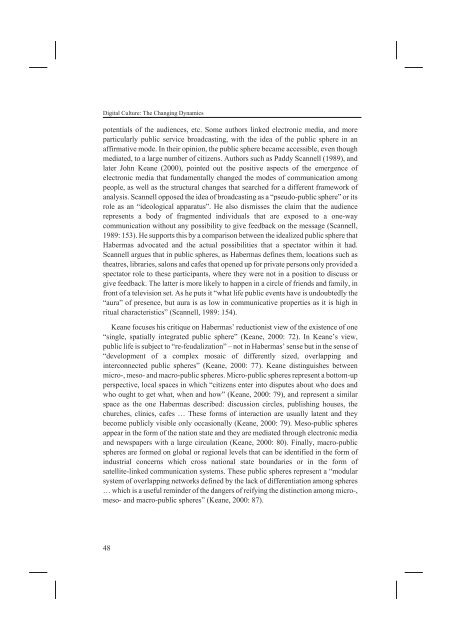D:\Documents and Settings\Ana\My Documents\Biserka-knjiga ...
D:\Documents and Settings\Ana\My Documents\Biserka-knjiga ...
D:\Documents and Settings\Ana\My Documents\Biserka-knjiga ...
You also want an ePaper? Increase the reach of your titles
YUMPU automatically turns print PDFs into web optimized ePapers that Google loves.
Digital Culture: The Changing Dynamics<br />
potentials of the audiences, etc. Some authors linked electronic media, <strong>and</strong> more<br />
particularly public service broadcasting, with the idea of the public sphere in an<br />
affirmative mode. In their opinion, the public sphere became accessible, even though<br />
mediated, to a large number of citizens. Authors such as Paddy Scannell (1989), <strong>and</strong><br />
later John Keane (2000), pointed out the positive aspects of the emergence of<br />
electronic media that fundamentally changed the modes of communication among<br />
people, as well as the structural changes that searched for a different framework of<br />
analysis. Scannell opposed the idea of broadcasting as a “pseudo-public sphere” or its<br />
role as an “ideological apparatus”. He also dismisses the claim that the audience<br />
represents a body of fragmented individuals that are exposed to a one-way<br />
communication without any possibility to give feedback on the message (Scannell,<br />
1989: 153). He supports this by a comparison between the idealized public sphere that<br />
Habermas advocated <strong>and</strong> the actual possibilities that a spectator within it had.<br />
Scannell argues that in public spheres, as Habermas defines them, locations such as<br />
theatres, libraries, salons <strong>and</strong> cafes that opened up for private persons only provided a<br />
spectator role to these participants, where they were not in a position to discuss or<br />
give feedback. The latter is more likely to happen in a circle of friends <strong>and</strong> family, in<br />
front of a television set. As he puts it “what life public events have is undoubtedly the<br />
“aura” of presence, but aura is as low in communicative properties as it is high in<br />
ritual characteristics” (Scannell, 1989: 154).<br />
Keane focuses his critique on Habermas’ reductionist view of the existence of one<br />
“single, spatially integrated public sphere” (Keane, 2000: 72). In Keane’s view,<br />
public life is subject to “re-feudalization” – not in Habermas’ sense but in the sense of<br />
“development of a complex mosaic of differently sized, overlapping <strong>and</strong><br />
interconnected public spheres” (Keane, 2000: 77). Keane distinguishes between<br />
micro-, meso- <strong>and</strong> macro-public spheres. Micro-public spheres represent a bottom-up<br />
perspective, local spaces in which “citizens enter into disputes about who does <strong>and</strong><br />
who ought to get what, when <strong>and</strong> how” (Keane, 2000: 79), <strong>and</strong> represent a similar<br />
space as the one Habermas described: discussion circles, publishing houses, the<br />
churches, clinics, cafes … These forms of interaction are usually latent <strong>and</strong> they<br />
become publicly visible only occasionally (Keane, 2000: 79). Meso-public spheres<br />
appear in the form of the nation state <strong>and</strong> they are mediated through electronic media<br />
<strong>and</strong> newspapers with a large circulation (Keane, 2000: 80). Finally, macro-public<br />
spheres are formed on global or regional levels that can be identified in the form of<br />
industrial concerns which cross national state boundaries or in the form of<br />
satellite-linked communication systems. These public spheres represent a “modular<br />
system of overlapping networks defined by the lack of differentiation among spheres<br />
… which is a useful reminder of the dangers of reifying the distinction among micro-,<br />
meso- <strong>and</strong> macro-public spheres” (Keane, 2000: 87).<br />
48



